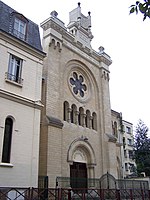Versailles, Yvelines

Versailles (French pronunciation: [vɛʁsɑj] ) is a commune in the department of the Yvelines, Île-de-France, renowned worldwide for the Château de Versailles and the gardens of Versailles, designated UNESCO World Heritage Sites. Located in the western suburbs of the French capital, 17.1 km (10.6 mi) from the centre of Paris, Versailles is a wealthy suburb of Paris with a service-based economy and is a major tourist destination. According to the 2017 census, the population of the city is 85,862 inhabitants, down from a peak of 94,145 in 1975.A new town founded at the will of King Louis XIV, Versailles was the de facto capital of the Kingdom of France for over a century, from 1682 to 1789, before becoming the cradle of the French Revolution. After having lost its status as a royal city, it became the préfecture (regional capital) of the Seine-et-Oise département in 1790, then of Yvelines in 1968. It is also a Roman Catholic diocese. Versailles is historically known for numerous treaties such as the Treaty of Paris, which ended the American Revolution, and the Treaty of Versailles, after World War I. Today, the Congress of France – the name given to the body created when both houses of the French Parliament, the National Assembly and the Senate, meet – gathers in the Château de Versailles to vote on revisions to the Constitution.
Excerpt from the Wikipedia article Versailles, Yvelines (License: CC BY-SA 3.0, Authors, Images).Versailles, Yvelines
Avenue de Saint-Cloud, Versailles
Geographical coordinates (GPS) Address Nearby Places Show on map
Geographical coordinates (GPS)
| Latitude | Longitude |
|---|---|
| N 48.8053 ° | E 2.135 ° |
Address
Avenue de Saint-Cloud
Avenue de Saint-Cloud
78000 Versailles, Notre-Dame
Ile-de-France, France
Open on Google Maps









